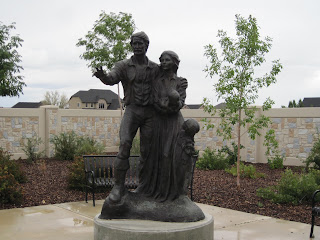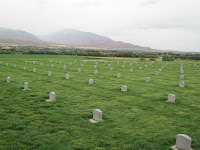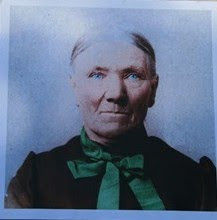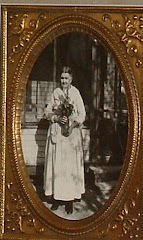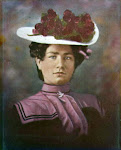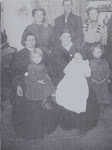 |
| Selena Marshall Gregory |
SELENA MARSHALL’S LIFE STORY
Author Unknown - Posted as Written
Selena Marshall was the daughter of Thomas Marshall and Sarah Goode. Selena was born February 22, 1844 at Linton Hill, Herefordshire, England. She was baptized August 13, 1854.
They had joined the saints, but Brother Thomas Marshall did not have good health and died in England. After his death sister Marshall still was very anxious to come to America. She had the courage and desire to emigrate to Utah. She had five daughters and one son. One of the daughters was a frail sickly child, and on that account she hesitated to leave their comfortable home, but she had a blessing given to her, in which she was promised, she would go to Salt Lake Valley and not lose a child. This was a great encouragement to her. She made preparations as fast as she could for their departure from England. She and her children left Linton Hill, Herefordshire, England in April, 1856 by railroad to Liverpool, where they sailed on the ship “S. Curling” with Samuel Curling as master. Dan Jones was president of the company on board, comprising 800 souls of L.D.S. saints, mostly all of them were Welsh stock.
Selena’s mother also paid emigration for her sister, Maria Goode, who was unmarried. Sister Marshall was 34 years of age, and the children were: Lavinia 12, Selena 10, Tryphinia 8, Louisa 6, George 4, and Sarah 2 and Maria Goode 25 years of age. They sailed from Liverpool on the 19th of April, 1856, and landed in Boston on the 23rd of May, 1856 where they boarded a train for Iowa City, arriving there on June 2, 1856.
A few days after their arrival on camp grounds, they joined the handcart company and headed for Salt Lake Valley with Edmund Ellsworth and Daniel McArthur as their captain and leader. This was the first hand cart company headed for Salt Lake Valley. Selena was next to the oldest child, and she had the responsibilities of helping her younger sisters and brothers along while her mother and eldest sister pulled the handcart. Everyone, even the small children had to walk, unless they were ill.
Every person in the company was given a pint of flour a day to make whatever they wanted to do with it. Selena always made her share into bread, and kept most of it to coax her sisters and brother along and it helped a great deal when they were so tired and weary. She sometimes helped others in their camp by gathering wood for their campfires. Some were thought wealthier than others for they had more supplies in their camp. These people at times gave bread to Selena for her help. She would keep it to coax the children along, as it helped so much to keep the children moving along ahead of the hand carts. Selena asked her Father in Heaven to take away her appetite so that she could give her rations to the younger ones more easily. She got very weak and made tea from wild herbs to strengthen her, but she seldom got hungry.
 |
Selena with sisters Sarah and Louisa
Selena is sitting |
When the children were tired, she offered them a small piece of bread if they would go to a bush or rock that she would point out ahead, and she took turns carrying them a little ways to rest them. When they reached the chosen place, she would give them a bite of bread. This was a very long and tiresome journey for these brave souls.
 |
| Tryphena Marshall Hunt |
They encountered a very disheartening experience on their journey. When the company had stopped to make camp after a long hard day, they found that one of Selena’s sisters was missing.(Tryphinia) Many were alarmed but the captain tried to quiet them by saying that the wolves would have her by that time, and he didn’t want anymore lives lost by trying to rescue her. Selena and her mother really felt that they could find the child and started back in search for her. After going a short distance from camp, they both knelt down in prayer. Her mother had a feeling immediately that she would find her child and they did find her huddled up close to a large bunch of grass near the trail. They hurried along with light and happy hearts with the finding of her. The wolves howled on all sides of them, but they were so thankful to find the lost one, that they were not afraid. The mother didn’t forget the promise made to her in the beginning of her journey westward, and it buoyed her on the road to her goal. On their way back to camp, three men of the company came to meet them. They arrived back to camp in the early morning in time to go on with the company that day.
 |
| Brother Brigham brought a treat of ginger snap cookies |
When the company was two days from Salt Lake Valley, Brigham Young and a few other men came to welcome and cheer them on. Brother Young brought them a treat of ginger snaps. Each child was given three cookies. There was not enough for all the grown ups. Selena kept most of hers for her little brother and sisters. Their journey proved a very hard one, and conditions were very bad in Salt Lake Valley. They arrived on September 26, 1856 and camped a week to rest. As conditions were so bad, they went on to Ogden and made their home at William Wadleighs residence for a while. He was very good to them and helped them in many ways. Mrs. Marshall married Joseph Chadwick in 1857. Mr. Chadwick didn’t prove to be a good husband to Selena’s mother, and she obtained a divorce in the beginning of 1860. That spring she left Ogden and took her family to Cache Valley, arriving in Franklin, Idaho April 14, 1860 where she made her home.

Selena worked very hard to help her mother get a home, and they planted a garden and small crops. She went to the canyon for wood and also plowed with an ox team. She became acquainted with a good man who was a widower, and who had just previously come to Franklin. He was from England and Selena was 18 years old now and anxious to get a home of her own. She married Robert Gregory, son of John Gregory and Elizabeth Sylvester, on the 2nd of January, 1863. Bishop Preston Thomas performed the ceremony. They were quiet about their marriage, and Bishop Thomas left a dance during intermission to marry the couple at the bride’s home. They lived a short time with Selena’s mother, then made a home out in the Franklin Fort. Selena was very happy and contented with her fine husband, and she gave birth to a daughter on October 17, 1863.
The town Franklin was divided in 1864 into one-fourth acre lots. With eight lots to a block, Selena’s husband was given a lot on the south of the public square. They raised a good crop of potatoes that year, and started to build them a house on their lot. They had this year for their share, 80 bushels of wheat, which they sold for flour and other necessities. Wheat was worth $5 a bushel and potatoes $2 a bushel. They surely felt like they were on the road to prosperity. They bought a team and wagon, which they badly needed. In January, 1865, they received their endowments and Selena acted as proxy for her husband’s first wife, Mary Stevens Gregory, who died while they were crossing the plains at Fort Laramie Wyoming. The weather was extremely cold and their ears were frozen while returning home from Salt Lake City. When they got back as far as Smithfield, their little daughter was very sick and broke out with measles. They stayed with brother McCann until Mary Lavinia was well enough to be moved to Franklin.
Brother Gregory purchased more land out south of Franklin, which they called the south field, but which later was named Mount Hope, then later called Cove. When the ward was divided into two precincts, Cove was the south ward. On January 6, 1866, Selena gave birth to another girl, whom they named Sarah Selena.
 |
| Wild Parsnip |
In the summer of 1867, a sad experience happened. Their daughter, Mary, with two other little girls of the neighborhood wandered away into the south fields near spring creek. They picked a bouquet of poison parsnips and ate some of them on the way home. The girls became deathly sick. With great difficulty they saved Mary’s life, and the life of Emma Pree, but the neighbor girl could not be made to vomit up the poison, thus causing her death.
Another daughter was born February 1, 1868 and named Charlotte Maria. This year, their crops were much better and grasshopper pests were not so bad.
In November, 1883, the Y.L. M.I.A. (Young Ladies Mutual Improvement Association) was organized, with Selena taking the office of President. Her husband, Robert, acted as first counselor in the Y.M.M.I.A. (Young Men’s Mutual Improvement Association). In 1894, the primary organization was effected and Selena served as counselor, continuing to labor in this organization for six years. Selena served as Relief Society visiting teacher until her health would not permit her to serve any longer. She enjoyed good health, however, until her family was grown and all married. She was the mother of thirteen children, eight girls and five boys. Three children died in infancy, but all the rest married and had large families, also. They all worked in the church in their respective wards. Her husband, Robert Gregory died suddenly while asleep in bed at the home of their second daughter, Sarah G. Porter, which whom he was visiting for a few days. The date of his death was December 28, 1900.
 |
| Selena Marshall Gregory 1888 |
Selena acted as nurse and midwife and helped many, many people through sickness, epidemics and childbirth. It is estimated that she brought 2000 or more babies into the world, including all her grandchildren. She also nursed under doctor Adaminson and he swore by her. There were many, many times a doctor would send patients to Selena, telling them that she could do more for them than he could do. She was good and stayed by her patients until they were out of danger.
 |
| Selena Marshall Gregory |
She was very kind and helpful to everyone, a very good cook and home maker. She knew how to work and do many kinds of art and needle work. She could knit a stocking or mitten with her eyes closed, and did this many times while telling stories to her grandchildren, of her many experiences crossing the plains. Selena never had a chance for book learning or to go to school during her whole life.
In 1914, she bought a small home in south Franklin, Idaho, thereby leaving the home in Cove to her boys, George and Thomas. They each bought an equal part of the farm from her. She became a victim of sugar diabetes and suffered several years from that disease. She cared for herself until December, 1917, when she became bedfast and died at the home of Charlotte G. Preece, on January 1, 1918.
She left numerous posterity- sons and daughters, grandchildren and great-grandchildren. She was a noble wife and other with a sterling character, and did much good in this world. All loved her and her wonderful ways. She was buried in Franklin, Idaho.
 |
Robert and Selena Gregory Monument
Franklin Cemetery Idaho |
__________________________________
Source:
Author unknown


























